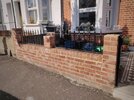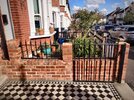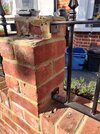Hi everyone,
18 months ago I had two front garden walls built with reclaimed London Bricks. There are six piers along the two walls. Three of them have already had their top layer of bricks come loose and are not properly fixed to the main wall anymore (they wobble but are held in place by the railings).
The pier which holds the gate post has an iron bar in it (see photo), which makes it more solid, but even that isn't properly attached to the lower wall anymore (held on by railings though).
Any advice on cause/how to rectify would be much appreciated. Some of the piers have been rebuilt two/three times and it keeps happening - the builder is flummoxed
Cheers
18 months ago I had two front garden walls built with reclaimed London Bricks. There are six piers along the two walls. Three of them have already had their top layer of bricks come loose and are not properly fixed to the main wall anymore (they wobble but are held in place by the railings).
The pier which holds the gate post has an iron bar in it (see photo), which makes it more solid, but even that isn't properly attached to the lower wall anymore (held on by railings though).
Any advice on cause/how to rectify would be much appreciated. Some of the piers have been rebuilt two/three times and it keeps happening - the builder is flummoxed
Cheers






